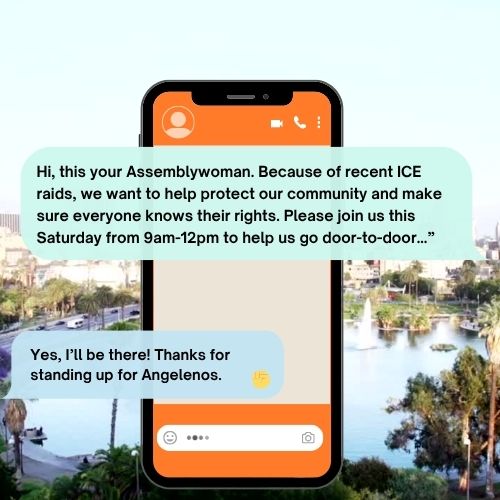
The Case for Conversational Texting
Organizing
It's not a billboard, it's a conversation.

Suzy Gold
5 min to read
minute read
When you reach voters on their phones, your initial message matters and influences your conversion rate, the information you gather, and the success of your overall program. We tell our clients all the time that texting is not a billboard. It’s a two-way conversation and you should design a program that elicits feedback, gathers data, and builds trust with voters. At Good Fight Political, we have overseen thousands of texting campaigns and understand what works when it comes to speaking to voters. Here are a few tips:
- Engagement Over Broadcast: Traditional messaging methods often resemble billboards—static and one-sided. In contrast, conversational texting scripts invite voters to participate in a dialogue. This two-way communication fosters a sense of involvement and respect, making voters more likely to engage with the campaign.
- Personalization: A script that opens the door for conversation can be tailored to the individual voter. By asking questions and responding to answers, campaigns can make each interaction feel unique and personal. This approach not only humanizes the campaign but also makes voters feel valued and heard.
- Data Collection: Conversational texts are a goldmine for collecting valuable data. By asking voters about their opinions, preferences, and concerns, campaigns can gather insights that inform their strategies. This data can help refine messaging, target specific voter groups, and address key issues that matter to the electorate.
- Building Relationships: Politics is about building relationships and trust. Conversational texting creates an opportunity for campaigns to establish a rapport with voters. Per industry standards, you must list your organization name and it also helps voters understand how and why they’re receiving the messages. By engaging in meaningful conversations, campaigns can build a loyal and supportive voter base that feels connected to the cause.
- Higher Response Rates: Our analysis has shown that scripts designed to elicit feedback have higher response rates compared to generic broadcast messages. Voters are more likely to reply when they feel their input is being sought and valued, leading to more dynamic and fruitful interactions.
Best Practices for Crafting Conversational Texts
- Start with a Question: Open your text with a question that encourages a response. This could be about a local issue, a candidate's stance, or simply asking for feedback on a campaign event.
- Be Authentic: Use a tone that feels natural and genuine. Voters can sense when messages are scripted and impersonal. Authenticity builds trust and rapport.
- Listen and Respond: Treat each reply as the beginning of a conversation. Respond thoughtfully to answers and continue the dialogue. This approach not only collects data but also strengthens voter relationships.
- Follow Up: One and done is never an effective strategy for reaching your survey goals or penetrating a voter universe in a meaningful way. Good Fight Political will help design a cadence and volume that fits your budget and allows for follow-up so you’re able to reach your goals.
Let's connect with us.
No minimums
No surprise bills
Free hands-on onboarding & support
Self-serve to fully-managed to fit every campaign's needs
Get started now
Give us a call: 323-810-9532




